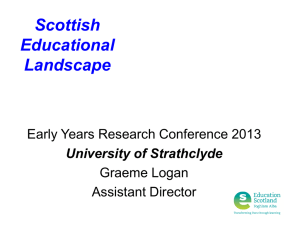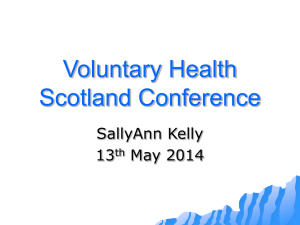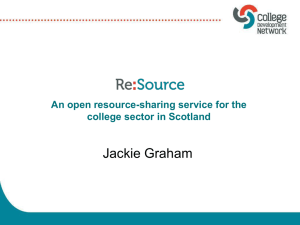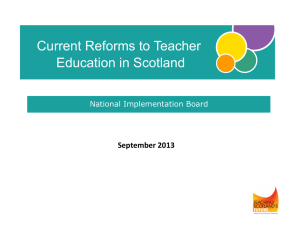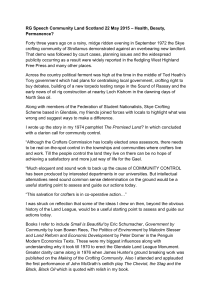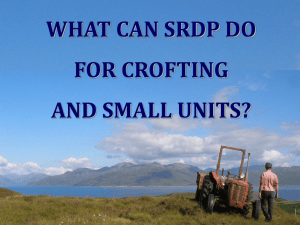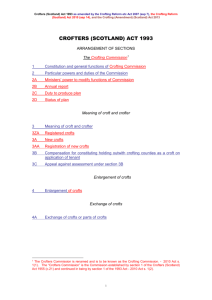Community land ownership in Scotland, retrospect and prospect
advertisement
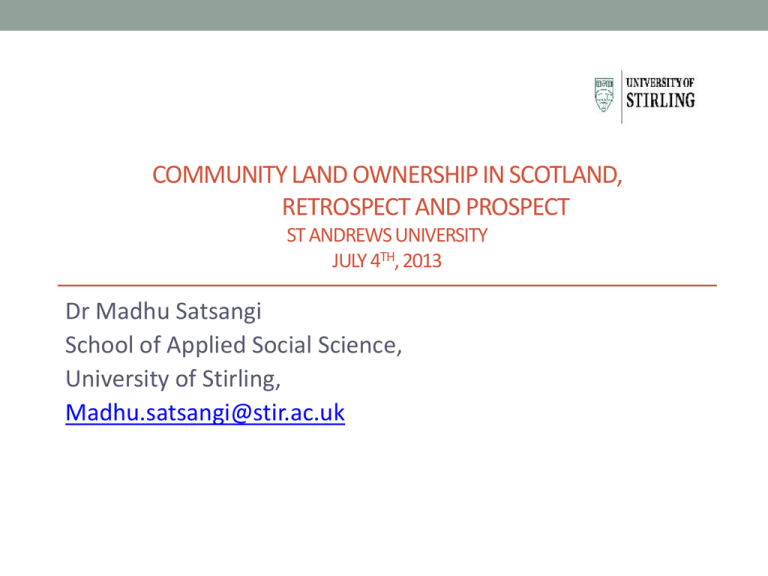
COMMUNITY LAND OWNERSHIP IN SCOTLAND, RETROSPECT AND PROSPECT ST ANDREWS UNIVERSITY JULY 4TH, 2013 Dr Madhu Satsangi School of Applied Social Science, University of Stirling, Madhu.satsangi@stir.ac.uk Outline • The origins of community land ownership • Community land ownership motives and outcomes • Constraints on growing community land ownership • Prospectus • Where are we now: Andy Wightman’s work shows half of the country is held by just 432 owners and 16 owners hold 10% of Scotland • NB This presentation is my personal view, not the position of the Rural Housing Service nor the Land Reform Review Group. The origins of community land ownership • A history of struggle over land rights • Power and powerlessness most acutely seen in the Highland – • • • • and Lowland – clearances In second half of 19th Century, tenant protest over lack of security through rent strikes and land raids across H+I. Inspired by Irish land struggle Creation of crofting tenure in 1886 Act – security of tenure for existing crofts First trust Glendale Estate, Skye (1908) scene of much struggle in 19th Century. Second longest surviving trust originated in ‘gift’ of land from its owner. Trusts for land originate in USA to increase security for black sharecroppers. The origins of community land ownership Community land ownership motives and outcomes • History shows communities taking the opportunity to buy when they can and when motivated and, in some cases, enabled to do so. • Why do communities buy the land they live on? Land is the foundation for all other development. • Qualitative data show emphasis on long-term stewardship, investment and growth. • Some purchases directly motivated by negative experiences of community decline under private ownership: Gigha, Eigg: • : “...under his (Schellenberg’s) ownership of Eigg, it had kept ‘its slightly rundown...Hebridean feel’” (Satsangi, 2007) Community land ownership motives and outcomes • Ownership outcomes: • new business development, • affordable housing : new and upgrading older stock (Gigha) • renewable energy schemes (Gigha, but also many community windfarms) • infrastructure development, eg premises for businesses • ongoing estate management. • Very visible outcomes in increased population and school numbers, Gigha again most celebrated. Constraints on growing community land ownership • Becoming an owner is a long, demanding process • Needs skills that have to be sourced within communities • • • • • themselves, or bought in Needs financial support, BIG + SLF Legislative hurdles: NB no purchases under Part 3 of Land Reform Act Needs skill in bringing whole community together and maintaining that Community land trust governance will need to deal with tensions Prospectus • CLS members cover 500,000 acres currently, FM wants 1m acres in community ownership by 2020 (ie about 5% of land area). • Feasible with fiscal and legislative support • SLF getting additional £3m in 2015-16, will need to be sustained • Adjustments to 2003 Act? questions on flexibility of timescales, are information requirements too onerous, are community groups being prevented from registering an interest in land after it has been put up for sale. • Simplification of CRtB for crofting communities? • Extension of CRtB to non-crofting areas? The ECHR is not a barrier (Allen, 2010) • Is Community Right of Sale a better way forward? (Adams, 2013) Sources • Adams, D (2013) The potential for urban land reform in Scotland, paper to AESOP-ACSP Joint • • • • • • • • • Congress, http://eprints.gla.ac.uk/81527/ Allen, T (2010) Liberalism, social democracy and the value of property under the European Convention of Human Rights, International and comparative law quarterly, 59(4), 1055-1078. Bryden, J and Geisler, C (2007) Community-based land reform: lessons from Scotland, Land Use Policy, 24(1), 24-34. Community Land Scotland, thanks for map at http://www.communitylandscotland.co.uk/index.php/home/5 accessed June 28th, 2013. Macleod, C. (2013) Lights out for radical land reform? http://calummacleodblog.wordpress.com/2013/06/12/lights-out-for-radical-land-reform-alexsalmonds-community-land-scotland-conference-speech/ accessed July 3rd, 2013 Salmond, A (2013) First Minister’s address to Community Land Scotland annual conference, http://83.223.124.6/~communi1/images/uploads/First_Minister_address__Community_Land_Scotland_Annual_Conference_2013.pdf accessed July 3rd, 2013 Satsangi, M (2007) Land tenure change and rural housing in Scotland, Scottish Geographical Journal, 123(1), 33-47. Satsangi, M, Gallent, N and Bevan, M (2010) The rural housing question: communities and planning in Britain’s countrysides, Bristol: Policy Press. Skerratt, S (2011) Community land ownership and community resilience, Edinburgh: SAC; thanks for timeline. Skerratt, S (2013) Enhancing the analysis of rural community resilience: evidence from community land ownership, Journal of Rural Studies, 31(1), 36-46.

